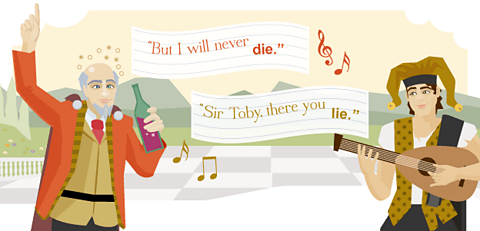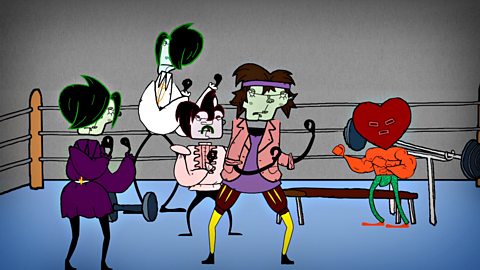Themes
There are many themes that run throughout the play Twelfth Night. Explore the main themes of love, appearance and reality and ambition looking at how they affect characters and influence the story.
Key themes
Twelfth Night was traditionally a day of celebration when everything was turned on its head. People would dress up, often swapping social roles, dance and drink the night away. Even though it is a comedy, based on a day of partying, Twelfth Night still deals with some serious themes. Romantic love, family love and even the love of love are all presented, as is the question of appearance and reality. The foolishness of ambition is shown through the actions of Olivia’s steward Malvolio and the cross-dressing Viola/Cesario makes us think about the importance of gender.
The main themes in Twelfth Night are:
- love
- appearance and reality
- ambition
Love
The very first line of the play is about love, and much of the comedy revolves around one character or another being in love with someone they cannot have. Orsino’s love for Olivia is unrequitedA feeling that is not returned or reciprocated.; Viola’s love for Orsino has to remain a secret as long as she pretends to be Cesario; and Olivia’s love for Cesario is farcical because, as the audience knows, he is actually Viola!
A quick summary exploring the theme of love in Shakespeare’s Twelfth Night
VOICEOVER
Love gets put through its paces in Twelfth Night.
There’s Orsino, Duke of Ilyria, who’s madly in lovewith Countess Olivia.
It doesn’t matter what Olivia says, he’s not going to
stop fancying her.
There’s Olivia. She falls in love with Cesario,who doesn’t return her affections.
And Cesario, who’s really Viola dressed up as a man,falls in love with Orsino. She can’t show her true feelings.
And Malvolio does show his true feelings, but they’re basedon a lie. He’s definitely wasting his time.
Oh crikey. Looks like love’s going to fight them all.But remember, love winning is a good thing.
It’s just that winning can be messy.
But Shakespeare always tidies up in the end,which is just as well.
What are you cleaning up with? Truth.
That’s what Shakespeare recommends for a Love Mess.
The love between friends is also presented with Antonio’s loyalty to Sebastian, though Malvolio’s love for Olivia, as encouraged by Maria’s fake letter, is seen as a madness.
Analysis of love
Question
How does love affect Viola in a negative way throughout most of the play?
Viola is in love with Orsino but can’t tell him. Viola realises that her love for Orsino must go unrecognised because he thinks she is a man. Her love is pure and patient though, and will wait forever.
VIOLA
She sat like Patience on a monument,
Smiling at grief. Was not this love indeed?
Act 2 Scene 4
Question
How does Orsino view love?
Orsino seems in love with the idea of being in love. He says that being in love is largely the work of a vivid imagination.
ORSINO
So full of shapes is fancy,
That it alone is high fantastical.
Act 1 Scene 1
Question
How is the love between Antonio and Sebastian portrayed?
The audience see a friendly love develop between Antonio and Sebastian. Sebastian has missed his companion during the short time they have been separated. He talks of physical pain that the loss of Antonio seems to have caused him.
SEBASTIAN
How have the hours racked and tortured me,
Since I have lost thee!
Act 5 Scene 1
You can find the theme of love in other plays by Shakespeare:
- A Midsummer Night’s Dream – in this comedy, a group of young Athenians find their true loves with a little help from some fairies
- Romeo and Juliet – this tragedy is all about the love between two teenagers from warring families
- Much Ado About Nothing – there’s lots of mix-ups and miscommunication in this comedy, but love rules in the end and everything turns out fine
Did you know? At the time when Shakespeare was writing, it was common for parents to choose suitable people for their children to marry. Sebastian and Viola are orphans, so they can choose for themselves
Appearance and reality
With Viola’s disguise and Maria’s forged letter, we see that nothing in Illyria is quite as it seems. Olivia thinks she has fallen in love with a young man, but the reality is that her beloved Cesario is Viola in disguise. Viola in turn is in love with Orsino, but can only refer to her feelings in hints and double meanings. Malvolio is convinced he has found a letter revealing Olivia’s secret love for him; in reality it is a trick to make him look foolish. Later Sebastian’s arrival on the scene causes even more confusion as he is mistaken for Cesario and vice versa.
Analysis of appearance and reality in the play
Question
How does Shakespeare use Viola’s disguise to demonstrate the theme of appearance and reality?
Viola’s disguise causes much of the confusion in the play. She says:
VIOLA
I am not what I am.
Act 3 Scene 1
Viola’s decision to disguise herself as a boy results in her being unable to reveal her true feelings, or to be honest with other characters until Sebastian turns up at the end. Her negative statement shows that how she appears is less important than her true self.
A summary exploring the theme of appearance and reality in Shakespeare’s Twelfth Night
Shakespeare knew that appearing to be something
you’re really not, could lead to new adventures;
exciting - yes, but sometimes confusing or dangerous.
Give up. You’re too old to get in.
The central character in Twelfth Night is a girl, Viola,
who can pass for a boy, Cesario.
It’s a brilliant disguise.
Just remember which door to go through….
Oh, look, it’s Cesario’s new boss, Orsino.
Viola falls in love with him, but she can’t declare her
love because she’s disguised as a boy.
And if it wasn’t complicated enough,
Olivia falls in love with Cesario.
Oh, Good grief. Here comes Viola’s twin Sebastian.
His appearance is even more confusing.
Olivia proposes to him, thinking it’s Cesario.
Shakespeare shows us how hard it can be to tell
appearance from reality, but how also how much
this confusion can teach us about ourselves.
After all, if it weren’t for Viola’s appearance as Cesario,
these couples would never have met!
But it’s only when the reality of who they are is known,
can true love blossom!
Hang on. They keep coming out of the gents.
What’s going on in there?
They’re sneaking in!
Oh dear. It appears that Shakespeare’s missed a trick.
I’ve never seen this before.
Question
How does the theme of appearance and reality unsettle and confuse Orsino?
Orsino is at first unsettled by the appearance of Sebastian. He says:
ORSINO
One face, one voice, one habit, and two persons.
Act 5 Scene 1
It appears that there are two versions of the same person. Of course the audience know the reality is that Sebastian and Viola are twins. This dramatic irony is farcical and funny.
You can find the theme of appearance and reality in lots of plays by Shakespeare:
- look at A Midsummer Night’s Dream - when the fairies interrupt the world of humans, appearances and reality become confused
- look at The Tempest - magic plays an important role in this comedy where things are not always as they seem
Ambition
The theme of ambition is largely presented by the character Malvolio and his deluded sense of self-importance. He daydreams about being married to Olivia and gaining the power to tell Sir Toby and Sir Andrew what he really thinks of their drunken behaviour. This ambitious nature ultimately leads to his downfall as Malvolio is the victim of a cruel practical joke.
A quick summary exploring the theme of ambition in Shakespeare’s Twelfth Night
VOICEOVERThere’s one very ambitious person in Twelfth Night.
Somebody who wants marriage to get him where he
wants to be in life.
No, not the pirate!
Malvolio, the Countess Olivia’s steward.
You might think Malvolio is a minor character,
but at one point in the sixteen hundreds,
they called the whole play ‘Malvolio’.
Audiences would have known someone like him.
A social climber, a snob, who fancied himself.
It’s not just the Countess that he wants, but her status!
Audiences loved to hate this pompous man!
And thought Maria’s fake love letter from Olivia was hilarious.
Shakespeare knew that we all love to hate people who think
they’re better than they are, and put other people down,
just to raise themselves’ up.
Some people need to be brought down a peg or two.
Malvolio doesn’t die. He just gets humiliated, publicly.Now that’s humiliation.
Analysis of ambition in the play
Question
Who does Shakespeare show to be the most ambitious character in the play?
Malvolio is a very ambitious character. He thinks he deserves more than his current status in life. He shouts:
MALVOLIO
To be Count Malvolio!
Act 2 Scene 5
He doesn’t express any actual love for Olivia in his daydream, but instead focuses on the power he would gain through the marriage.
Question
How does Malvolio’s blind ambition reduce him to the status of a fool?
At the end of the play, Olivia pities Malvolio for being taken in by the trick the others set for him. Rather than being raised to a position of Count, his status ends up lower than when the play began.
MALVOLIO
‘Alas, poor fool, how have they baffled thee!
Act 5 Scene 1
You can find the theme of ambition in lots of plays by Shakespeare:
- Macbeth - this tragedy takes a serious look at the side-effects of blind ambition
- Antony and Cleopatra - ambition is explored in the context of the Roman Empire
Test yourself
More on Twelfth Night
Find out more by working through a topic
- count4 of 5

- count5 of 5

- count1 of 5

- count2 of 5
